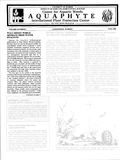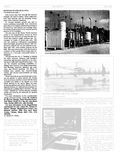

Among the futuristic technological achievements at Walt Disney World (Orlando, Florida) one is not seen by the general public: an experimental system which integrates a water hyacinth wastewater treatment process with a methane production facility. In the system, some wastewater from the attraction’s theme parks is cleansed by the action of water hyacinths, which are subsequently harvested and fed to a sophisticated anaerobic digestor for the production of usable methane. The project is sponsored by the Gas Research Institute (GRI) and according to them, “this research is expected to benefit the gas consumer and the public at large by providing local sources of pipeline-quality gas.” Results here may lead to the construction of commercial full-scale water hyacinth utilization facilities in the late 1980s.
The first part of the system is the hyacinth secondary and tertiary wastewater treatment process. After some solids have settled out as sludge in the “primary clarifier”, the water is diverted to concrete channels where the plants are cultured. Here, the plants remove unwanted nutrients and other pollutants, while complex organic wastes are broken down to simpler compounds by the bacteria which live on the water hyacinths. These simpler waste compounds are then utilized by the growing hyacinths. Under these conditions, the hyacinths grow luxuriantly.
After several days flow through the hyacinth channels, the water is clearer, waste compounds have been reduced, and the discharge stream meets water treatment standards.
To increase hyacinth growth rate and to remove polluting compounds from wastewater more effectively requires scheduled harvesting of the hyacinths, and scientists are studying which harvesting schedules best fit the seasonal growth patterns of the hyacinths.
The next part of the Disney World hyacinth system is the biogasification process in which harvested water hyacinths are anaerobically convrerted into pipeline quality methane gas. Encouraged by results of bench-scale tests, GRI built this scaled-up (1200-gallon) experimental unit which began operation in January 1984. Expperiments with this test unit are expected to continue until 1987, when another scale-up will be built. This next scale-up may verify the economic suitability of the concept before design and construction of a full-scale commercial facility is attempted.
The pictured test unit is "designed to include the major physical, chemical, and biological operations and processes essential to the functioning of a full-scale biogasification plant.” The unit has complete processing capabilities including water hyacinth and sludge preparation, feed blending, anaerobic digestion, gas treatment, and effluent handling. The effects of loading rates, particle size, hyacinth/sludge mixing, and pre- and post-treatment are being determined.
Water hyacinths are processed through a chopper and grinder to reduce particle size. Sludge from the primary clarifier is mixed with the water hyacinths and added to the digester as a feed blend. Bacteria in the reactor digest the feed, producing methane and carbon dioxide. The undigested residues are collected and processed for potential use as animal feed or fertilizer. The gas is then "cleaned up” (carbon dioxide, hydrogen sulfide and moisture are removed) for pipeline distribution.
[…]
| Id | 3486 |
|---|---|
| Availability | Free |
| Inserted | 2017-10-28 |